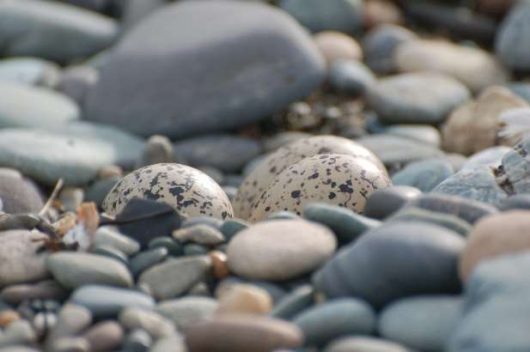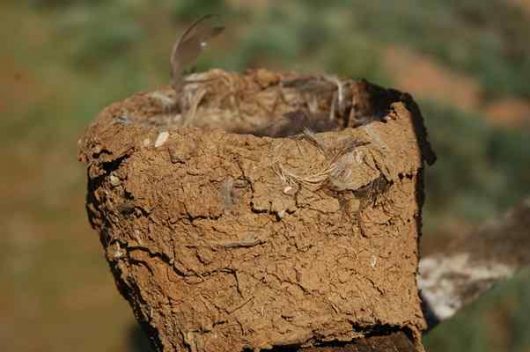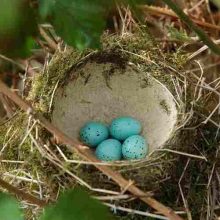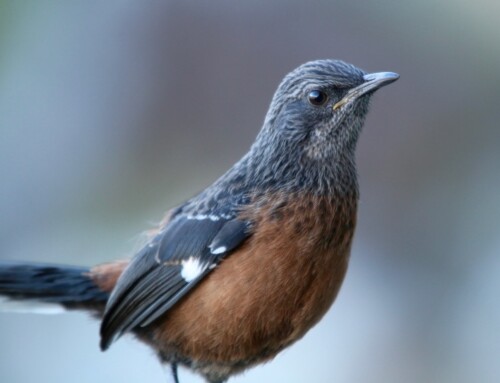Predicting the effects of climate change on the nesting behaviour of birds and other animals
LINKED PAPER
Climate change and nesting behaviour in vertebrates: a review of the ecological effects and potential for adaptive responses. Mainwaring, M.C., Barber, I., Deeming, D.C., Pike, D.A., Roznik, E.A. & Hartley, I.R. 2017. Biological Reviews. DOI: 10.1111/brv.12317. VIEW
Climate change affects breeding birds in a variety of ways. Perhaps most notably, studies of migratory Pied and Collared Flycatchers, Ficedula hypoleuca and F. albicollis, have shown that they are struggling to arrive back on their European breeding grounds in time to breed when their caterpillar prey is most abundant. Whilst such studies have proved enlightening, there is a growing realisation that animals may also be affected by climate change during other stages of reproduction, including when nest building.
This is because nest building behaviours are influenced by changes in environmental conditions, for example, Long-tailed Tits Aegithalos caudatus reduce the number of feathers they use to line their nests as spring advances as increasing temperatures reduce the need for insulating materials (McGowan et al., 2004). Meanwhile, Blue and Great Tits, Cyanistes caeruleus and Parus major, breeding in northerly locations build better-insulated nests than conspecifics further south (Mainwaring et al., 2012) and Hawaiian Honeycreepers Chlorodrepanis virens breeding at higher altitudes increase their nests’ exposure to the sun’s rays by locating their nests in more exposed areas of tree canopies than conspecifics at lower altitudes (Kern & van Riper, 1984). Such changes are important because the offspring may develop abnormally or even die if they spend too much time outside of physiologically acceptable temperature limits (DuRant et al., 2013). Here, I outline some of the ways in which climate change may impact on the nesting behaviours of birds and other animals.
Let’s begin with the direct ways. First, rising sea levels and an increase in the frequency of tropical storms are likely to increase the flood risk to nests of many species. Sea-level rises are projected to rise between 0.26 and 0.63 m by 2081 and 2100 which means that the huge numbers of nesting seabirds and shorebirds are at risk. Some specific predictions are that 11% of Kentish Plover Charadrius alexandrinus nests are likely to be flooded if there are even modest sea level rises in the Farasan Islands in Saudi Arabia, whilst 26% of nests will flood if the sea level rises by 1 metre (AlRashidi et al., 2012). Furthermore, the nests of shorebirds may well be relatively safe in the short term from flooding under normal high tides, but they are vulnerable to larger storms during extreme weather conditions. Such extreme weather conditions occurred with increasing frequency between 1971 and 2008 on the Wadden Sea, where the maximum high tide levels increased at twice the rate of the mean high tide level. The increasing frequency of extreme weather events increased the risk of flooding for many shorebirds but most worryingly, reduced the reproductive output of Eurasian Oystercatchers Haematopus ostralegus below the level required for their population to remain stable (van de Pol et al., 2010).

Second, climate change may reduce the availability of nesting sites and building materials for some species. For example, a fascinating study showed that the availability of scrub and trees as nesting and foraging sites for some American passerine birds has decreased. As over-winter temperatures have increased over time, the subsequent reductions in snow cover have enabled increasing numbers of elk to occupy North American woodlands throughout the winter months. Browsing activity of these elk populations has reduced the growth of saplings and limited their availability as nesting sites in the subsequent summer months (Martin & Maron, 2012). Experimentally excluding elk from woodland plots reversed long-term declines in both plant and bird populations, and confirmed the direct effect of winter browsing on the availability of nest sites for birds (Martin & Maron, 2012). Meanwhile, increasing temperature and decreasing rainfall may reduce the availability of mud, an important nest-building material for many nesting birds (Møller, 2006) and for some species, such as the Struthideidae family of mud-nesting birds in Australia, the only material.

Third, climate change is having dramatic population-scale consequences for species with temperature-dependent sex determination (TSD). For species with TSD, equal numbers of male and female offspring are produced at a pivotal nest temperature, whereas higher nest temperatures result in female-biased sex ratios and lower nest temperatures result in male-biased sex ratios. Studies of sea turtles have shown that nest temperature changes as small as ~1°C can lead to female-biased hatchling sex ratios and thus eventually, female-biased populations (Laloë et al., 2014) and the same is likely to be occurring in the megapodes, the only birds with TSD (Göth & Booth, 2005).
In addition to the direct threats highlighted above, climate change may also indirectly affect nest-building birds by altering their interactions with nest predators and parasites. For example, passerine bird nests are predated more frequently at higher ambient temperatures than at lower temperatures (Cox, Thompson & Reidy, 2013; DeGregorio et al., 2015). In the Arctic, polar bears have traditionally hunted seals on the thick sea ice during the winter months, but as increasing temperatures have driven the earlier loss of the sea ice, the bears have switched to eating alternative terrestrial prey such as the eggs of ground- and cliff-nesting seabirds, such as Common Eiders Somateria mollissima and Thick-billed Murres Uria lomvia (Iverson et al., 2014).
Nests are built by birds to provide a suitable environment for the growth of their own offspring but nests often inadvertently create ideal homes for parasites to reproduce. Such ectoparasites reduce the breeding success of their hosts and so host species have evolved a range of defences against nest parasites. Whilst such defences limit parasites, they may become less effective if host–parasite interactions become altered under climate change since climatic conditions influence the abundance of parasites in nests in complex ways (Dawson, Hillen & Whitworth, 2005; Martínez-de la Puente et al., 2009).
On a slightly larger scale, avian brood parasites such as cuckoos and cowbirds often use nest characteristics to locate the nests of potential hosts (Moskát & Honza, 2000). Shifts in the phenology of brood parasites and hosts (Douglas et al., 2010), the prevalence and virulence of brood parasites (Møller et al., 2011) and/or the defences hosts can mount against brood parasites (Berkowic et al., 2015) may all have an impact upon avian nest-building behaviour.

So, how much potential is there for nest-building birds to make adaptive responses to ongoing climate change? Well, the observed capacity of birds and reptiles to adjust their nest site selection decisions and construction behaviours allows for some optimism, although our understanding is generally limited. Changes may result from phenotypic plasticity whereby birds change their behaviour during the course of their lifetime or from rapid evolutionary changes, via selection on construction behaviour. While studies of Barn Swallows Hirundo rustica indicate that nesting behaviour has a large genetic component (Møller, 2006), others studies do not (Brommer, Rattiste & Wilson, 2008) and so more research examining the genetic basis of nest–building behaviours is needed.

Specifically, birds may be able to adapt to climate change via alterations in their nesting phenology, patterns of nest-site selection and changes in nest design. Adaptations seem possible, as advances in the timing of a range of events, including tree bud bursts, flowering dates, and the migratory journeys and egg-laying dates of birds have been well documented. Such adaptive changes usually result from phenotypic plasticity and adaptive changes in nesting phenology enable animals such as blue tits to time their reproduction to coincide with the period of peak food availability. Meanwhile, megapodes with TSD may be able to increase the proportion of male hatchlings, or even restore sex ratios to parity, by nesting earlier in the season when ambient temperatures are cooler, although data from studies of sea turtles are not encouraging on that point (Laloë et al., 2014). Evidence from birds is lacking, but experimentally deepening painted turtle nests did not affect the temperature for eggs and thus had no effect on hatchling sex ratios (Refsnider et al., 2013).
Adaptive shifts in the locations in which nests are built may provide other means for birds to adapt to climate change, and crucially, such changes can occur during the lifetime of individuals thereby facilitating rapid changes. In tropical and sub-tropical environments, optimal temperatures for offspring growth are usually lower than the highest ambient temperatures and so nests should be expected to be located in cooler sites. Indeed, grasshopper sparrows and eastern meadowlarks living in arid environments preferentially select nest sites close to vegetation so that they are in shade from the hot midday sun (Long, Jensen & With, 2009). Birds breeding in hot environments are likely to choose progressively cooler sites over time, meaning that further changes are possible, although they are likely to be limited.
In summary, there is a need to develop a better understanding of the evolutionary constraints facing nest building birds (Mainwaring and Hartley 2009; Mainwaring et al., 2014). We especially need to know more about the relative roles of plasticity, heritability and evolutionary change to predict how climate change will impact on nest building behaviour.
References
AlRashidi, M., Shobrak, M., Al-Eissa, M.S. & Szekely, T. 2012. Integrating spatial data and shorebird nesting locations to predict the potential future impact of global warming on coastal habitats: a case study on Farasan Islands, Saudi Arabia. Saudi J. Biol. Sci. 19: 311-315. VIEW
Berkowic, D., Stokke, B.G., Meiri, S. & Markman, S. 2015. Climate change and coevolution in the cuckoo-reed warbler system. Evol. Ecol. 29: 581-597. VIEW
Brommer, J.E., Rattiste, K. & Wilson, A.J. 2008. Exploring plasticity in the wild: laying date-temperature reaction norms in Common Gulls Larus canus. Proc. R. Soc. B 275: 687-693. VIEW
Cox, W.A., Thompson, F.R. & Reidy, J.L. 2013. The effects of temperature on nest predation by mammals, birds, and snakes. Auk 130: 784-790. VIEW
Dawson, R.D., Hillen, K.K. & Whitworth, T.L. 2005. Effects of experimental variation in temperature on larval densities of parasitic Protocalliphora (Diptera: Calliphoridae) in nests of Tree Swallows (Passeriformes: Hirundinidae). Environ. Entomol. 34: 563-568. VIEW
DeGregorio, B.A., Westervelt, J.D., Weatherhead, P.J. & Sperry, J.H. 2015. Indirect effect of climate change: Shifts in ratsnake behavior alter intensity and timing of avian nest predation. Ecol. Model. 312: 239-246. VIEW
Douglas, D.J.T., Newson, S.E., Leech, D.I., Noble, D.G. & Robinson, R.A. 2010. How important are climate-induced changes in host availability for population processes in an obligate brood parasites, the European Cuckoo? Oikos 119: 1834-1840. VIEW
DuRant, S.E., Hopkins, W.A., Walters, J.R. & Hepp, G.R. 2013. Ecological, evolutionary, and conservation implications of incubation temperature-dependent phenotypes in birds. Biol. Rev. 88: 499-509. VIEW
Göth, A. & Booth, B.T. 2005. Temperature-dependent sex ratio in a bird. Biol. Lett. 1: 31-33. VIEW
Iverson, S.A., Gilchrist, H.G., Smith, P.A., Gaston, A.J. & Forbes, M.R. 2014. Longer ice-fee seasons increase the risk of nest depredation by polar bears for colonial breeding birds in the Canadian Arctic. Proc. R. Soc. B 281: 20133128. VIEW
Kern, M.D. & van Riper, C. III. 1984. Altitudinal variations in nests of the Hawaiian Honeycreeper Hemignathus virens virens. Condor 86: 443-454. VIEW
Laloë, J-O., Cozens, J., Renom, B., Tazonera, A. & Hays, G.C. 2014. Effects of rising temperature on the viability of an important sea turtle rookery. Nat. Clim. Change 4: 513-518. VIEW
Long, A.M., Jensen, W.E. & With, K.A. 2009. Orientation of Grasshopper Sparrow and Eastern Meadowlark nests in relation to wind direction. Condor 111: 395-399. VIEW
Mainwaring, M.C. & Hartley, I.R. 2009. Experimental evidence for state-dependent nest weight in the Blue Tit, Cyanistes caeruleus. Behav. Proc. 81: 144-146. VIEW
Mainwaring, M.C., Hartley, I.R., Lambrechts, M.M. & Deeming, D.C. 2014. The design and function of birds’ nests. Ecol. Evol. 4: 3909-3928. VIEW
Mainwaring, M.C., Hartley, I.R., Bearhop, S., Brulez, K., du Feu, C.R., Murphy, G., Plummer, K., Webber, S.L., Reynolds, S.J. & Deeming, D.C. 2012. Latitudinal variation in Blue Tit and Great Tit nest characteristics indicates environmental adjustment. J. Biogeog. 39: 1669-1677. VIEW
Martin, T.E. & Maron, J.L. 2012. Climate impacts on bird and plant communities. Nat. Clim. Change 2: 195-200. VIEW
Martínez-de la Puente, J., Merino, S., Lobato, E., Rivero-de Aguilar, J., Cerro, S.D., Ruiz-de-Castañeda, R. & Moreno, J. 2009. Does weather affect biting fly abundance in avian nests? J. Avian Biol. 40: 653-657. VIEW
McGowan, A., Sharp, S.P. & Hatchwell, B.J. 2004. The structure and function of nests of Long-tailed Tits Aegithalos caudatus. Functional Ecology 18: 578-583. VIEW
Møller, A.P. 2006. Rapid change in nest size of a bird related to change in a secondary sexual character. Behav. Ecol. 17: 108-116. VIEW
Møller, A.P., Saino, N., Adamík, P., Ambrosini, R., Antonov, A., Campobello, D., Stokke, B. G., Fossøy, F., Lehikoinen, E., Martin-Vivaldi, M., Moksnes, A., Moskat, C., Røskaft, E., Rubolini, D., Schulze-Hagen, K., Soler, M. & Shykoff, J.A. 2011. Rapid change in host use of the Common Cuckoo Cuculus canorus linked to climate change. Proc. R. Soc. B 278: 733-738. VIEW
Moskát, C. & Honza, M. 2000. Effect of nest and nest site characteristics on the risk of Cuckoo Cuculus canorus parasitism in the Great Reed Warbler Acrocephalus arundinaceus. Ecography 23: 335-341. VIEW
Refsnider, J.M., Bodensteiner, J.L., Reneker, J.L. & Janzen, F.J. 2013. Nest depth may not compensate for sex ratio skews caused by climate change in turtles. Anim. Cons. 16: 481-490. VIEW
van de Pol, M., Ens, B.J., Heg, D., Brouwer, L., Krol, J, Maier, M., Exo, K-M., Oosterbeek, K., Lok, T., Eising, C. & Koffijberg, K. 2010. Do changes in the frequency, magnitude and timing of extreme climatic events threaten the population viability of coastal birds? J. Appl. Ecol. 47: 720-730. VIEW
Image credit
Featured image: Song Thrush Turdus philomelos nest © Mark C. Mainwaring
If you want to write about your research in #theBOUblog, then please see here.





